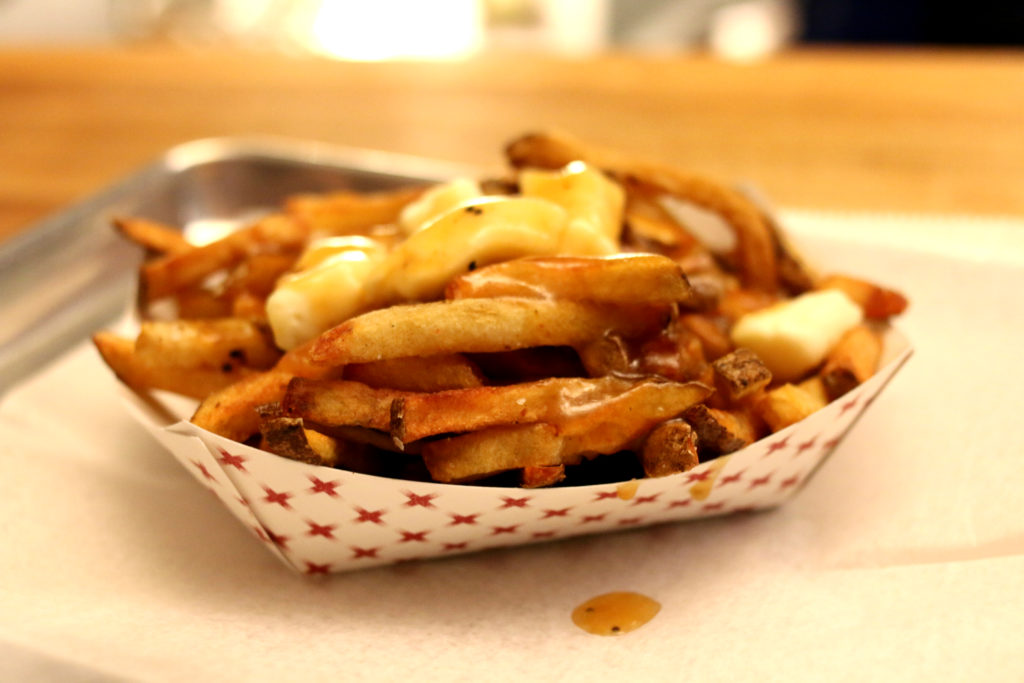
Poutine, a Canadian staple named after a Québécois slang word meaning “mess,” is an unbeatable combination of French fries topped with cheese curds and brown gravy. Each component of poutine is indulgent enough on its own, but when you layer them together on a plate, it creates a perfect balance of savory and fatty.
My first poutine experience was at Duck Fat, a cozy restaurant in Portland, Maine, that uses their namesake ingredient in many of their dishes. We ordered the poutine, and when that plate of crispy fries came out covered in rich duck gravy with cheese curds and a sprinkling of chives, my heart almost stopped. My stomach just growled thinking about that dish. So, when I heard that Saus in the North End was doing a poutine pop-up in Cambridge, I knew I had to go and satisfy my poutine craving.

However, the event’s brewery location — with a snaking line out the door — and my underage status didn’t make for the best combination. But I was not deterred. My friend and I went directly to Saus the next day to try their poutine, which co-owner Tanya Walker said is “one of the most delicious things you can do with fries,” in an email to The News.
It is definitely not a dish for the health conscious. For reference, an order of medium fries from Burger King has close to 400 calories, and that’s before you add on cheese curds and a decadent meat-based gravy. So if someone ever tries to sell you “healthy poutine,” they’re lying either about “healthy” or “poutine.”
There seems to be some discrepancy when it comes to the true origins of poutine, but according to Mental Floss, the most well-known claim is that it was concocted in 1957 in Warwick, Québec. At the restaurant L’Ideal, where owner Fernand Lachance sold both cheese curds and fries, a rushing customer asked him to throw the two together in a bag. As the story goes, Lachance looked at the mess he created and declared, “This is a ‘poutine.’” The name stuck.

Gravy came into the picture in 1964 when some customers at Le Roy Jucep in Drummondville, Québec ordered cheese curds to go along with a patented gravy and fries dish at the restaurant. Sensing an opportunity, owner Jean-Paul Roy added this concoction to the menu and the traditional form of poutine was born.
The dishes started catching on all across Canada and became commercially popularized in the 1990s, when chains like McDonald’s and Harvey’s added it to their menus, according to The Canadian Encyclopedia.
The website also mentions that poutine has become a symbol of Québec. Despite criticism of this dish regarding its messiness and high fat content — in 2003, a group of Toronto mothers successfully petitioned to remove poutine from local school cafeterias — its fans far outnumber its detractors.
At Saus, a restaurant that features fries and a wide variety of dipping sauces, along with other menu items such as sandwiches, poutine was one of the things that co-owners Walker, Chin Kuo and Renee Eliah enjoyed and received a strong request for. At Saus, a restaurant that features fries and a wide variety of dipping sauces, along with other menu items such as sandwiches, poutine was one of the things that co-owners Walker, Chin Kuo and Renee Eliah enjoyed and received a strong request for.
“If our group of friends was a sample size of potential customers and they unanimously said, ‘poutine!’ and we — Chin, Renee and I — wanted poutine, it seemed to point that it would be a huge success on our menu,” Walker said. “And we weren’t wrong.”
I wasn’t brave enough to tackle a serving of poutine on my own, so my friend and I split a regular order that came with their classic gravy and cheese curds. As tempting as the pork belly topping looked, I thought it would be best to go for the traditional style.
The fries themselves were crispy with a lot of skins, which I’m a big fan of because of the papery-thin crunch they lend to the potatoes. I think thicker-cut fries would have been ideal to hold the gravy, because toward the bottom some of the fries were soaked through; however, Saus’ gravy was just flavorful enough where this wasn’t a problem.
Walker says that their gravy is what sets their poutine apart from other poutines in the area, and it takes two days to make. “We start with chicken bones and beef and we stick by it. We don’t open a flavor packet of ‘brown gravy,’” Walker said.
The cheese curds, slightly melty from sitting on top of the warm fries and gravy, gave a nice bite to the dish and were pleasantly squeaky: an indicator of quality curds. They are also essential to a good poutine.
“We use actual, real cheese curds,” Walker said. “We have to source them from several different farms in New England to keep up with our demand, but it’s worth it. Without naming any names, there are a few restaurants in Boston that do poutine without using real cheese curds. I don’t blame them. Cheese curds are expensive and hard to find in this area.”
I left Saus feeling more than satisfied with the poutine, happy to know that this Canadian dish was only a few stops away on the Green Line, near the Haymarket station. Whether it’s to warm you up on a chilly day or to fulfill a craving for something greasy and delicious, there’s always an excuse to indulge in some poutine. And Walker’s take on poutine’s popularity really sums it all up:
“Fried potatoes, gooey cheese, savory gravy: all things people crave.”















